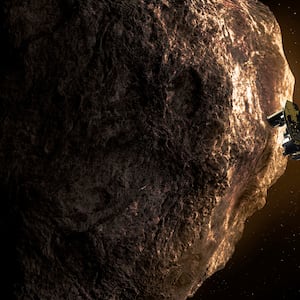To hear Elena Adams tell it, our planet is under constant assault—from space dust and debris, chunks of rock, and artifacts from the formation of the solar system, to name a few. And these objects are raining down on us incessantly at bewildering speeds.
“Earth gets bombarded all the time with stuff,” Adams, a systems engineer at the Johns Hopkins Applied Physics Laboratory, told The Daily Beast.
Usually, that’s not a problem. The atmosphere handily takes care of the bulk of space junk that tries to get through, burning it into cosmic ash that we mortals on land never have to worry about.
But bigger things occasionally get through that can cause serious damage. In 2013 an asteroid the size of a small apartment building exploded 14 miles over Chelyabinsk, Russia, creating a nuclear-level blast and sending shock waves that broke windows over 200 square miles, injuring some 1,600 people.
While we can go, on average, centuries or millennia without an asteroid impact that could, say, take out your hometown, “‘on average’ isn’t always necessarily a good guide of the real next time something’s going to happen,” said Andy Rivkin, a planetary astronomer at the Applied Physics Lab. We need “an insurance policy.”
That’s why on Nov. 24, at 1:20 a.m. ET, NASA is launching its DART mission to see if it can ram into an asteroid and knock it off its course.
“If there was an asteroid coming towards Earth, we want to be able to be protected,” said Adams, DART’s lead missions systems engineer. “We don’t want to be dinosaurs.”
At 25 meters across, an asteroid the size of the one in Chelyabinsk falls somewhere in the category of Bad News—big enough to cause injuries and probably scare the crap out of a lot of people, but likely not catastrophic. Something that’s 1,000 meters wide (about 0.6 miles) and we’re looking at civilization collapse, said Rivkin, who is an investigation team lead on DART. Fortunately, NASA has identified nearly all the potential planet-killers and doesn’t expect them to come knocking anytime in the foreseeable future.
It’s the ones in the middle size range that are a bit more worrisome. An asteroid about 140 meters across (one and a half football fields) could wipe out Washington, D.C., and take northern Virginia and southern Maryland with it. According to NASA there are probably 25,000 near-Earth asteroids around that size circling the sun—and the agency only has eyes on an estimated 40 percent of them. If our telescopes were to spot one heading our way, there’s nothing right now that we could do about it.
DART, which stands for Double Asteroid Redirection Test, is supposed to lay the groundwork to change that. It’s NASA’s first-ever planetary defense mission. The plan is equal parts simple and bonkers: Aim for one of these near-Earth asteroids and crash into it head-on. If the DART spacecraft can alter the speed of the asteroid, even by a millimeter per second, it will change its orbit. In the hypothetical case of an asteroid hurtling toward Earth, a slight orbital shift could be the difference between an awkward flyby and partial annihilation.
NASA’s asteroid target is Dimorphos, a 160-meter-wide mini-moon orbiting a larger 780-meter-wide asteroid named Didymos. Neither body is even a remote threat to Earth.
Built to be destroyed, DART is a 4-foot cube loaded with investigational tech, including a pair of 28-foot solar arrays that will unfurl as it travels through space. It will take nine months for DART to get close enough to even see the asteroid pair in its camera—at that point, from a distance of 10.5 million miles, the bigger asteroid will be a mere pixel in the field of view. As the DART approaches, it will take photos every five hours, helping NASA guide navigation from the ground. “We spend the whole month basically following that pixel trying to get closer to it,” said Adams.
About 10 days out from arrival, the spacecraft will release a small cube satellite built by the Italian Space Agency, which will capture footage of the mission’s grand finale from afar. In the final four hours, the main spacecraft will go into autonomous mode, steering itself toward its target and streaming images back to NASA.
But, Adams explained, there’s still not much to see. “You don’t get very good pictures until about 90 seconds to a minute out—at which point it’s a little bit too late.”
What she means is, by the time engineers on the ground receive the first clear images of Dimorphos, DART will have already crashed into it, leaving behind a sizable crater and a cloud of dust. Picture a school bus ramming the Great Pyramid of Giza at 15,000 miles per hour.
“If we keep hearing from it, that’s a problem,” Rivkin said.
The dual asteroid system is a useful test model in a couple of important ways. For one, Dimorphos is big enough that it could inflict some hurt if it were going to hit Earth—again, it won’t—so if the kinetic impact method actually shifts its orbit, it’s proof it should be viable against a real threat.
Second, the asteroid is locked in a relatively short orbit around Didymos, completing a revolution roughly every 12 hours. Watching it through ground telescopes, scientists will be able to tell within a matter of days if its orbit has hastened, proving the mission was a success. (Rivkin and others will judge this by watching how frequently the sunlight reflected off Didymos dims as Dimorphos goes by.)
“I’m really excited that NASA is doing this,” Philip Lubin, a professor of physics at the University of California, Santa Barbara, told The Daily Beast. “I love the fact that people are seriously looking at planetary defense.”
With enough warning time, at least a decade or two, hitting an oncoming asteroid with an interstellar cue ball could prevent catastrophe. But if scientists were to spot something that could hit us in a year, or a month, or a week, the kinetic impact method wouldn’t work. The other options would be to knock it off course with a nuclear device (which Rivkin pointed out “cannot be tested without breaking all sorts of international law”); to draw it in with the gravity of a massive spacecraft that has yet to be invented; or to employ civil defense—a technical term for telling the citizenry to duck and cover.
Lubin has another idea: pulverize it.
His idea is to break up an approaching asteroid into smaller pieces that would mostly burn upon entering the atmosphere and therefore do less damage. To do it would require launching a rocket (like the Falcon 9) full of penetrators—metal or composite ceramic rods several feet in length—toward the object. The rocket would release several rows of penetrators in the asteroid’s path, which would chip away at the rock from the outside in, like carving a block of ice.
Lubin’s slice and dice approach (called Pi, for “pulverize it,” and described in a paper not yet peer-reviewed) could, in theory, be launched within days or even minutes of an impact. Lubin said it’d be good to have both tools in the toolbelt.
Last month, a 2-meter asteroid made a close pass of Earth—closer than TV satellites—and scientists didn’t notice until it had gone by. “We are lucky in general,” Lubin said about the near-miss. “Not a great long term strategy.”







